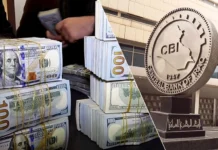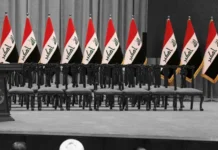Tishwash: Can budget tables save Iraq from a financial crisis? An expert answers.
Political and economic circles are anticipating the budget tables will be submitted to Parliament within the next two months, amid questions about their ability to address a potential financial crisis.
In this context, economic expert Salah Nouri explained to {Euphrates News} that “the success of these schedules depends on several key factors, most notably the nature of the spending schedules. If an austerity portfolio focuses on only necessary expenditures, it may mitigate the severity of the crisis.”
He added, “It also requires resolving issues with the US Federal Reserve to ensure the full transfer of oil revenues.”
Nouri stressed the “necessity of maintaining the planned oil selling price in the general budget, which reaches $70 per barrel,” noting that “taking these factors into account will be a decisive factor in the budget’s ability to confront financial challenges and ensure economic stability for the country. link
Tishwash: Association of Banks: Payment points increased to 60,000, and more than 18 million electronic cards were issued.
The Iraqi Private Banks Association announced on Sunday the issuance of more than 18 million electronic payment cards across the country, while noting that the number of payment points has increased to approximately 60,000.
Ali Tariq, executive director of the Iraqi Private Banks Association, told the Iraqi News Agency (INA), “The issuance of electronic cards in the country is witnessing a significant increase, particularly following government decisions to promote electronic payments and oblige government and private institutions to collect electronically.”
He explained that “the number of cards issued has exceeded 18 million in Iraq, while the number of electronic payment points has increased from 7,000 to approximately 60,000, with further increases expected in the coming period.”
He added, “Banks continue to support various projects,” explaining that “financial ceilings for small, medium, and large projects are determined by each financial institution based on the nature of the project, its capital, and the number of employees link
************
Tishwash: Iraqi markets teeter between the official and parallel currencies. A relentless struggle drives up the exchange rate.
It appears that government measures and the Central Bank’s attempts to control the dollar exchange rate have not achieved complete success, as exchange rates continue to witness significant fluctuations in the markets, amid increasing pressures resulting from unofficially covered demand, smuggling operations, and the complications of recent customs decisions.
The US dollar exchange rate rose in the markets of Baghdad and Erbil, the capital of the Kurdistan Region, after successive declines witnessed in recent days, raising concerns among citizens and traders alike.
The Al-Kifah and Al-Harithiya stock exchanges in Baghdad recorded 141,600 dinars for $100, while the selling price in exchange shops in local markets recorded 142,500 dinars for $100, after the dollar recorded 139,000 dinars for $100 this month.
Experts believe that the continued fluctuation reflects the limited impact of government measures and the Central Bank, as unofficial market factors, such as demand related to trade with neighboring countries and smuggling through ports, continue to pressure the stability of the dinar.
These people point out that addressing the crisis requires broader solutions than just financial decisions, including reforming the customs system, strengthening control over border crossings, and revitalizing non-oil economic sectors to reduce excessive reliance on the dollar.
Expectations of Rise
In turn, economic expert Ahmed Abd Rabbo expects a further rise in the dollar exchange rate, noting that the previous decline was a result of the downturn witnessed in the markets, which created a state of anxiety in financial transactions.
Abd Rabbo told Al-Mada that “the talk about the suspension of some remittances and problems with online shopping led to a rush on the dollar in the parallel market, which will lead to a renewed rise in the price.”
He added that “stabilizing the dollar price requires practical plans and real market control, so that the Central Bank can understand the problems and seek effective solutions through the banking system,” stressing that “such steps will contribute to controlling prices and calming the market.”
He pointed out that “seriously addressing the factors affecting supply and demand, in addition to monitoring parallel market movements, are key to achieving real stability in the dollar price.”
Traders point out that the gap between the official and parallel markets still exists, which opens the door to daily speculation and makes any temporary decline vulnerable to rapid dissipation. While citizens are optimistic about any decline in the exchange rate, concerns remain about a renewed rise, accompanied by a new wave of inflation that will put pressure on the livelihood of Iraqi families.
Three main factors
For his part, financial and banking expert Abdul Rahman Al-Shaikhly attributed the reasons for the fluctuations in the dollar exchange rate in Iraq to three main factors, stressing that these factors work together to increase pressure on the market.
Al-Shaikhly explained to Al-Mada that “the first reason is the scarcity of supply compared to the increasing demand, which creates a state of tension in the exchange market.”
He added, “The second reason is the insistence of many traders on importing their goods from neighboring banned countries, especially in light of the Central Bank’s occasional delay in providing dollars to importers through official outlets. The third reason is the price difference between the official market and the parallel market, which has encouraged speculators to take advantage of this disparity, especially in light of the current increase in demand.”
He stressed that “understanding these reasons and taking measures to control supply and demand, in addition to monitoring price differences between markets, represents an important step towards stabilizing the dollar price in Iraqi markets.”
The Iraqi public had been optimistic about the decline in the dollar price in recent weeks, hoping that this would be reflected in price stability and a decline in commodity costs. However, the ongoing volatility has dispelled these expectations, after the price rose again, affected by the increase in demand that is not officially covered and the slowness of government solutions, which has left the public facing renewed concerns about a new wave of looming inflation. link





